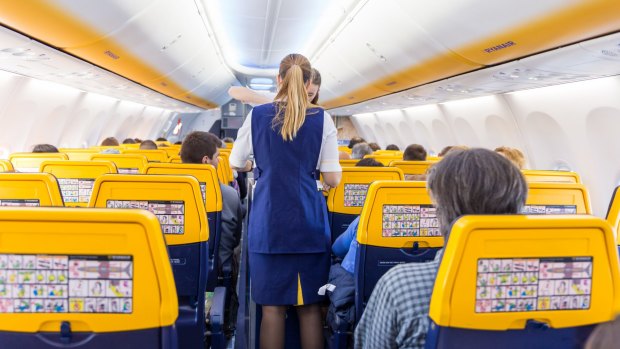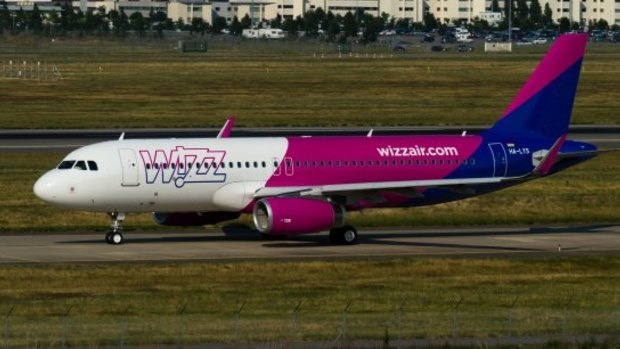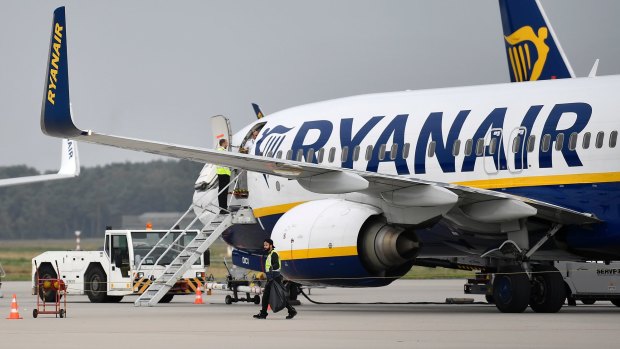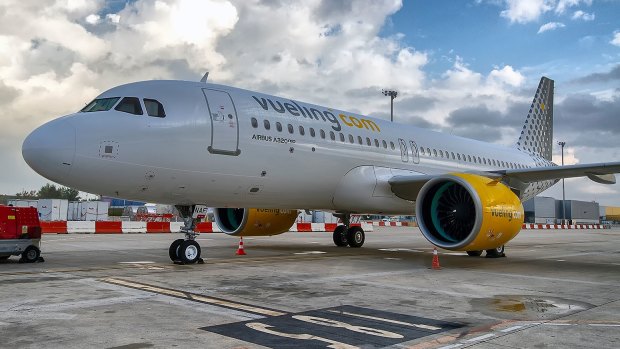This was published 4 years ago
Budget airlines in Europe: Why you should never fly the cheapest option
By Michael Gebicki

Ryanair's low fares and number of routes make it tempting when flying in Europe.Credit: Shutterstock
You can fly from Frankfurt to Barcelona for €3.99 ($A6.37). London to Nice? That's €7.99, or how about London to Fes in Morocco for €22.98? Or Manchester to Cagliari at the southern tip of Sardinia for €14.99?
You'll be flying aboard a low-cost carrier, and the skies of Europe are laced with the white contrails of cheap airlines. Huge and relatively affluent populations packed together into a relatively small area plus the EU's open skies policy have allowed budget airlines to thrive.
But while the prices look phenomenal, that's just the bait. Once you take it, you're meat on the airline's plate. Expect to be filleted. Low-cost carriers also come with an inherent misery factor that might make you wish you'd shelled out for a ticket with a full-service airline instead.

Fly Wizz Air to Rome and you'll find yourself at an airport that's a long way from the actual city.
The airport might be a long way from the city
I just flew from Rome to Bucharest with Wizz Air, a low-cost Hungarian carrier. Rather than Rome's main airport, Fiumicino, Wizz Air and several other budget carries use Ciampino Airport. I'd arrived in Rome Fiumicino on a late evening flight and spent the night in a hotel close to the airport. The only practical way to get to Ciampino early the next morning was by taxi, which cost €60. If I'd flown out of Fiumicino the taxi ride would have cost €20 at most.
The big international airports that serve major cities charge high fees to the airlines that use them. Budget airlines prefer to use alternative airports where they pay less.

Ryanair has been voted the world's worst airline six years in a row.Credit: AP
Ryanair, which gives other airlines looking to fly lean and mean their template, operates many flights to Paris, but not to Charles de Gaulle, the main airport, but Paris-Beauvais. Don't be fooled by the "Paris" in the name – Paris Beauvais is in the Picardy region, 85 kilometres north-northwest of Paris. The other "Paris" airport to which Ryanair flies is Paris Vatry. That's 22 kilometres southeast of Chalons-en-Champagne. Prime if you want to visit the Champagne region, but almost three hours by shuttle and train from Paris.
Expect a terminal with minimal facilities
Typical of the alternative airports that low-cost carriers prefer, Rome's Ciampino is distinguished by a lack of seating, shopping, toilets, minimal food and beverage outlets and queues for everything.

Expect tight seats on budget carriers like Vueling.
Worst of all, on the morning I flew, was the queue at the immigration desk, which stretched back to fill almost half of the modest terminal, yet there were only three officers on duty. So slow was the progress that airline personnel were marching up and down the lines calling passengers forward for flights approaching departure time. These passengers were shunted to a separate line and thus there were only two officials left to process passengers on non-prioritised flights.
Since this was Italy, queuing was notional. Many pushed in from the sides and – this being Italy – they were allowed to get away with it. From the time I joined the queue to the time I fronted up at the immigration counter took 45 minutes.
Expect to catch a bus out to your aircraft
Low-cost carriers do not typically use an airbridge to board their aircraft. Airbridges incur a higher fee, and therefore budget airlines tend to park their aircraft some way distant from the terminal. That means you'll probably be bussed out to your aircraft and bussed back at the other end.
Loathe as I am to join the lemming rush to board, there are typically two buses and you want to be on the first. If you're on the second you might find all the overhead luggage bins within cooee of your seat are already packed. If you have to store your gear in a bin further back in the aircraft you'll have to wait until passengers in the seats behind have disembarked before you can retrieve your luggage.
You might be flying Ryanair
It's the airline all flyers love to hate, and love to fly. The sheer size of Ryanair, which carries more passengers across international borders than any other airline, the number of routes they fly, and their temptingly low base fares make it almost impossible to avoid this behemoth if you want to fly around Europe on the cheap.
Their modus operandi works like a charm, no doubt about it. Ryanair's load factor for April 2019 was 96 per cent, a figure to make other airline execs weep. But Ryanair looks to every opportunity to squeeze a few more drops of blood from its passengers.
Forget to check in online and that'll cost you £55 ($A102) when you show up at the airport. Checked in but neglected to print out your boarding pass? That's £25. You can get onboard with a small carry-on at the advertised fare but a 20-kilogram bag will set you back £40 and if you want to book a seat, £3. Of course there are no free drinks or snacks onboard.
At the end of 2018 Ryanair took the gong for the world's worst airline for the sixth consecutive year in a survey by Which?. No surprise there.
Seats too close for comfort
Seats on low-cost airlines are among the tightest in the skies. Aboard the single-aisle Boeing 737-800 that is the workhorse of Ryanair's fleet, seat pitch is 30 inches (76.2cm), width is 17 inches (43cm). EasyJet goes 2.5cm less with its seat pitch but also the same distance wider. Vueling is the same on its Airbus A320 and 321 aircraft.
Don't bother reaching for the reline button either. Aboard most budget carriers there isn't one. Inflight entertainment, also nada. There is no seat-back screen, so BYO entertainment. If you want to select your seat that's another small fee in the pocket of your airline.
The problem with connecting flights
If you fly with a discount carrier and you have a connecting flight, you need to allow two hours between flights at a bare minimum. That's because you'll need time to retrieve your luggage and check back in, and that might involve passing through immigration as well as security screening.
Discount carriers won't transfer your bags to another carrier. They won't even transfer your baggage if your connecting flight is aboard the same carrier. If you miss your connecting flight and that flight was also with a no-frills airline, you've probably done your dough.
See also: The best stopover airports between Australia and Europe
See also: The world's best budget airlines
Sign up for the Traveller Deals newsletter
Get exclusive travel deals delivered straight to your inbox. Sign up now.